Optimization of Castor Oil-Based Ion Selective Electrode (ISE) with Active Agent 1,10-Phenanthroline for Aqueous Pb2+ Analysis
Abstract
:1. Introduction
2. Materials and Methods
2.1. Materials
2.2. Instruments
2.3. Preparation of 1,10 Phenantrolin-Immobilized PU Membrane
2.4. Preparation of Ag/AgCl Reference Electrode
2.5. Construction of Pb2+ Ions Selective Electrode (Pb2+ ISE)
2.6. Optimization of Pb2+ISE
2.6.1. Effect of 1,10-Phenanthroline Composition
2.6.2. Effect of Internal Solution Concentration
2.6.3. Effect of pH
2.7. Analytical Performance Analysis of Pb2+ ISE
2.7.1. Determination of Response Time
2.7.2. Repeatability Test
2.7.3. Reproducibility Test
2.7.4. Selectivity Test for Pb2+ ISE
2.7.5. Determination of Lifetime
2.8. Characterization of 1,10-Phenanthroline-Immobilized PU Membrane
3. Results and Discussion
3.1. Pb2+ ISE Optimization
3.1.1. Effect of 1,10-Phenanthroline Weight
3.1.2. Effect of Internal Solution Concentration
3.1.3. Effect of pH
3.1.4. Effect of TISAB Solution
3.2. Performance Characteristics of Pb2+ ISE
3.2.1. Profiles of Sensitivity, Linear Range, and LOD of Pb2+ ISE
3.2.2. Response Time
3.2.3. Repeatability of ISE
3.2.4. Reproducibility of the ISE
3.2.5. Selectivity of ISE
3.2.6. Lifetime
3.3. Characteristics of the 1,10 Phenanthroline-Immobilized PU Membrane before and after the Pb2+ Measurement
3.3.1. FT-IR
3.3.2. SEM
3.3.3. XRD
3.3.4. Mechanical Properties
3.4. Investigation on Real Sample
4. Conclusions
Author Contributions
Funding
Institutional Review Board Statement
Informed Consent Statement
Data Availability Statement
Conflicts of Interest
References
- Food and Drug Administration. Elemental Impurities Guidance for Industry; FDA: Silver Spring, MD, USA, 2015; pp. 1–85.
- Tarragó, O. Lead Toxicity Case Studies Environment Medicine; Department of Health and Human Services: Washington, DC, USA, 2015; pp. 2–30.
- Murphy, J. Additives for Plastics Handbook; Elsevier: New York, NY, USA, 2003; pp. 266–267. ISBN 85617 370 4. [Google Scholar]
- Völz, H.G.; Kischkewitz, J.; Woditsch, P.; Westerhaus, A.; Griebler, W.-D.; De Liedekerke, M.; Buxbaum, G.; Printzen, H.; Mansmann, M.; Räde, D.; et al. Pigments, Inorganic; Wiley-VCH Verlag GmbH & Co. KGaA: Weinheim, Germany, 2006; pp. 112–119. [Google Scholar] [CrossRef]
- Boldyrev, M. Lead: Properties, history, and applications. WikiJ. Sci. 2018, 1, 7. [Google Scholar] [CrossRef] [Green Version]
- Li, J.; Yin, T.; Qin, W. An all-solid-state polymeric membrane Pb2+-selective electrode with bimodal pore C60 as solid contact. Anal. Chim. Acta 2015, 876, 49–54. [Google Scholar] [CrossRef] [PubMed]
- Custodio, M.; Peñaloza, R.; Cuadrado, W.; Ochoa, S.; Álvarez, D.; Chanamé, F. Data on the detection of essential and toxic metals in soil and corn and barley grains by atomic absorption spectrophotometry and their effect on human health. Chem. Data Collect. 2021, 32, 100650. [Google Scholar] [CrossRef]
- Zaman, B.T.; Erulaş, A.F.; Chormey, D.S.; Bakirdere, S. Combination of stearic acid coated magnetic nanoparticle based sonication assisted dispersive solid phase extraction and slotted quartz tube-flame atomic absorption spectrophotometry for the accurate and sensitive determination of lead in red pepper samples and assessment of green profile. Food Chem. 2019, 303, 125396. [Google Scholar] [CrossRef]
- Musielak, M.; Kocot, K.; Zawisza, B.; Talik, E.; Margui, E.; Queralt, I.; Walczak, B.; Sitko, R. Ultratrace determination of metal ions using graphene oxide/carbon nanotubes loaded cellulose membranes and total-reflection X-ray fluorescence spectrometry: A green chemistry approach. Spectrochim. Acta Part B At. Spectrosc. 2021, 177, 106069. [Google Scholar] [CrossRef]
- Liu, Y.; Gao, Y.; Yan, R.; Huang, H.; Wang, P. Disposable Multi-Walled Carbon Nanotubes-Based Plasticizer-Free Solid-Contact Pb2+-Selective Electrodes with a Sub-PPB Detection Limit. Sensors 2019, 19, 2550. [Google Scholar] [CrossRef] [Green Version]
- Bühlmann, P.; Pretsch, E.; Bakker, E. Carrier-Based Ion-Selective Electrodes and Bulk Optodes. 2. Ionophores for Potentiometric and Optical Sensors. Chem. Rev. 1998, 98, 1593–1688. [Google Scholar] [CrossRef]
- Vassilev, V.; Tomova, K.; Boycheva, S. Pb(II)-ion-selective electrodes based on chalcogenide glasses. J. Non-Cryst. Solids 2007, 353, 2779–2784. [Google Scholar] [CrossRef]
- Khan, A.A.; Baig, U. Electrically conductive membrane of polyaniline–titanium(IV)phosphate cation exchange nanocomposite: Applicable for detection of Pb(II) using its ion-selective electrode. J. Ind. Eng. Chem. 2012, 18, 1937–1944. [Google Scholar] [CrossRef]
- Joon, N.K.; He, N.; Wagner, M.; Cárdenas, M.; Bobacka, J.; Lisak, G. Influence of phosphate buffer and proteins on the potentiometric response of a polymeric membrane-based solid-contact Pb(II) ion-selective electrode. Electrochim. Acta 2017, 252, 490–497. [Google Scholar] [CrossRef] [Green Version]
- Golcs, Á.; Horváth, V.; Huszthy, P.; Tóth, T. Fast Potentiometric Analysis of Lead in Aqueous Medium under Competitive Conditions Using an Acridono-Crown Ether Neutral Ionophore. Sensors 2018, 18, 1407. [Google Scholar] [CrossRef] [PubMed] [Green Version]
- Tang, W.; Yu, J.; Wang, Z.; Jeerapan, I.; Yin, L.; Zhang, F.; He, P. Label-free potentiometric aptasensing platform for the detection of Pb2+ based on guanine quadruplex structure. Anal. Chim. Acta 2019, 1078, 53–59. [Google Scholar] [CrossRef] [PubMed]
- Saiful, M.; Shaleha, S.; Rahmi, F. Tumbuhan Jarak Ricinus communis L. In Sintesis Membran Poliuretan Berbasis Bahan Alam; Syiah Kuala University: Banda Aceh, Indonesia, 2017; pp. 35–51. ISBN 978-602-1270-80-6. [Google Scholar]
- Baig, U.; Khan, A.A. Polyurethane-Based Cation Exchange Composite Membranes: 3 Preparation, Characterization and its Application in Development of 4 Ion-Selective Electrode for Detection of Copper(II). J. Ind. Eng. Chem. 2015, 29, 392–399. [Google Scholar] [CrossRef]
- Liu, D.; Meyerhoff, M.E.; Goldberg, H.D.; Brown, R.B. Potentiometric ion- and bioselective electrodes based on asymmetric polyurethane membranes. Anal. Chim. Acta 1993, 274, 37–46. [Google Scholar] [CrossRef] [Green Version]
- Papp, S.; Jágerszki, G.; Gyurcsanyi, R.E. Ion-Selective Electrodes Based on Hydrophilic Ionophore-Modified Nanopores. Angew. Chem. Int. Ed. 2018, 57, 4752–4755. [Google Scholar] [CrossRef] [Green Version]
- Alva, S.; Sundari, R.; Aziz, A.S.A.; Rashid, N.A.A.; Gunawan, W. Development of Ammonium-Selective Electrode Based on PVC/MB28 Membrane. IOP Conf. Ser. Mater. Sci. Eng. 2018, 453, 012042. [Google Scholar] [CrossRef]
- Alreja, P.; Kaur, N. Recent advances in 1,10-phenanthroline ligands for chemosensing of cations and anions. RSC Adv. 2016, 6, 23169–23217. [Google Scholar] [CrossRef]
- Elgamouz, A.; Shehadi, I.; Assal, A.; Bihi, A.; Kawde, A.-N. Effect of AgNPs internal solution on the sensing of mercury(II) by an ion-selective electrode based on a thiol coordination from cysteine as ionophore. J. Electroanal. Chem. 2021, 895, 115443. [Google Scholar] [CrossRef]
- Arida, H.A.; Al-Haddad, A.; Schöning, M.J. New solid-state organic membrane based leadselective micro-electrode. WIT Trans. Model. Simul. 2011, 51, 547–557. [Google Scholar] [CrossRef]
- Karimi, H. Effect of pH and Initial pb(II) Concentration on The Lead Removal Efficiency from Industrial Wastewater Using Ca(OH)2. Int. J. Water Wastewater Treat. 2017, 3, 1–8. [Google Scholar]
- Huang, F.; Wan, Z.; Jin, Y.; Wen, L. The Effects of Cyclic Isothermal Oxidation on Ir/IrOxpH Electrode and a Method to Correct the Potential Drift of Metal Oxide Electrode. J. Electrochem. Soc. 2017, 164, B632–B640. [Google Scholar] [CrossRef]
- Sekaran, R.J.; Bougie, U. Research Methods for Business: A skill Building. In Nuevos Sistemas de Comunicación e Información, 7th ed.; John Wiley & Sons Inc.: New York, NY, USA, 2016; pp. 2013–2015. [Google Scholar]
- Ganjali, M.R.; Norouzi, P.; Rezapour, M. Potentiometric Ion-Selective Sensors. In Encyclopedia of Sensors; American Scientific Publishers: Stevenson Ranch, CA, USA, 2006; Volume 8, p. 203. ISBN 1-58883-064-0. [Google Scholar]
- Hussien, E.M.; Derar, A.R. Selective Determination of Diclofenac and Clomiphene with a Single Planar Solid-State Potentiometric Ion Selective Electrode. J. Electrochem. Soc. 2019, 166, B780–B786. [Google Scholar] [CrossRef]
- Tang, X.; Wang, P.-Y.; Buchter, G. Ion-Selective Electrodes for Detection of Lead (II) in Drinking Water: A Mini-Review. Environments 2018, 5, 95. [Google Scholar] [CrossRef] [Green Version]
- Mei-Rong, H. Lead ion-selective electrodes based on polyphenylenediamine as unique solid ionophores. Talanta 2011, 83, 1575. [Google Scholar]
- Kamal, A.; Tejpal, R.; Bhalla, V.; Kumar, M.; Mahajan, R.K. Selective and sensitive lead (II) solid-contact potentiometric sensor based on naphthalene-sulfonamide derivative. Int. J. Environ. Sci. Technol. 2015, 12, 2567–2578. [Google Scholar] [CrossRef] [Green Version]
- Motawie, A.; Madani, M.; Esmail, E.; Dacrorry, A.; Othman, H.; Badr, M.; Abulyazied, D. Electrophysical characteristics of polyurethane/organo-bentonite nanocomposites. Egypt. J. Pet. 2014, 23, 379–387. [Google Scholar] [CrossRef] [Green Version]
- Liu, Y.; Liu, Y.; Xu, Y.; He, Q.; Yin, R.; Sun, P.; Dong, X. Phenanthroline bridging graphitic carbon nitride framework and Fe (II) ions to promote transfer of photogenerated electrons for selective photocatalytic reduction of Nitrophenols. J. Colloid Interface Sci. 2021, 608, 2088–2099. [Google Scholar] [CrossRef]
- Rahmi; Julinawati; Nina, M.; Fathana, H.; Iqhrammullah, M. Preparation and characterization of new magnetic chitosan-glycine-PEGDE (Fe3O4/Ch-G-P) beads for aqueous Cd(II) removal. J. Water Process Eng. 2022, 45, 102493. [Google Scholar] [CrossRef]
- Khan, S.U.; Sultan, M.; Islam, A.; Sabir, A.; Hafeez, S.; Bibi, I.; Ahmed, M.N.; Khan, S.M.; Khan, R.U.; Iqbal, M. Sodium alginate blended membrane with polyurethane: Desalination performance and antimicrobial activity evaluation. Int. J. Biol. Macromol. 2021, 182, 72–81. [Google Scholar] [CrossRef]
- Norouzi, A.; Lay, E.N.; Nareh, A.A.; Hosseinkhani, A.; Chapalaghi, M. Functionalized nanodiamonds in polyurethane mixed matrix membranes for carbon dioxide separation. Results Mater. 2021, 13, 100243. [Google Scholar] [CrossRef]
- Yan, Q.; Xin, B.; Chen, Z.; Liu, Y. Preparation and characterization of flexible Polypyrrole/Zirconium carbide/Polyurethane hybrid membranes with enhanced electro-photo-thermal performance. Mater. Today Commun. 2021, 29, 102877. [Google Scholar] [CrossRef]
- Yan, Q.; Xin, B.; Chen, Z.; Xu, J.; Du, X.; Li, Y.; Liu, Y.; Xu, L. Preparation and characterization of photothermal polyurethane/zirconium carbide fibrous membranes via electrospinning. J. Text. Inst. 2021, 113, 1324–1333. [Google Scholar] [CrossRef]
- Carreño, A.; Solís-Céspedes, E.; Zúñiga, C.; Nevermann, J.; Rivera-Zaldívar, M.M.; Gacitúa, M.; Ramírez-Osorio, A.; Páez-Hernández, D.; Arratia-Pérez, R.; Fuentes, J.A. Cyclic voltammetry, relativistic DFT calculations and biological test of cytotoxicity in walled-cell models of two classical rhenium (I) tricarbonyl complexes with 5-amine-1,10-phenanthroline. Chem. Phys. Lett. 2018, 715, 231–238. [Google Scholar] [CrossRef]
- Chavan, P.V.; Pandit, K.S.; Desai, U.V.; Kulkarni, M.A.; Wadgaonkar, P.P. Cellulose supported cuprous iodide nanoparticles (Cell-CuI NPs): A new heterogeneous and recyclable catalyst for the one pot synthesis of 1,4-disubstituted—1,2,3-triazoles in water. RSC Adv. 2014, 4, 42137–42146. [Google Scholar] [CrossRef]
- Hosseinzadeh, R.; Aghili, N.; Mavvaji, M. Synthesis and characterization of nano-cellulose immobilized phenanthroline-copper (I) complex as a recyclable and efficient catalyst for preparation of diaryl ethers, N-aryl amides and N-aryl heterocycles. Polyhedron 2021, 213, 115631. [Google Scholar] [CrossRef]
- Song, J.; Huang, T.; Qiu, H.; Niu, X.; Li, X.-M.; Xie, Y.; He, T. A critical review on membrane extraction with improved stability: Potential application for recycling metals from city mine. Desalination 2018, 440, 18–38. [Google Scholar] [CrossRef]
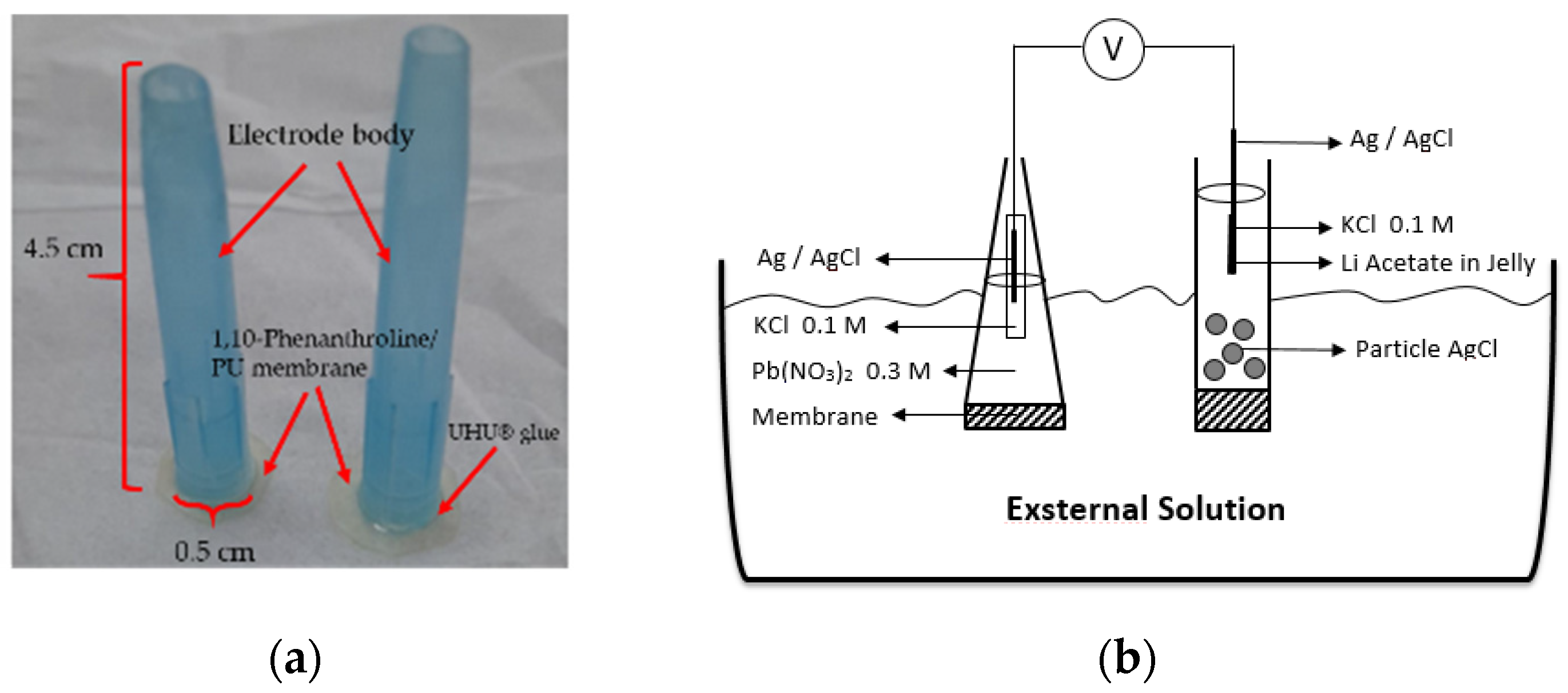
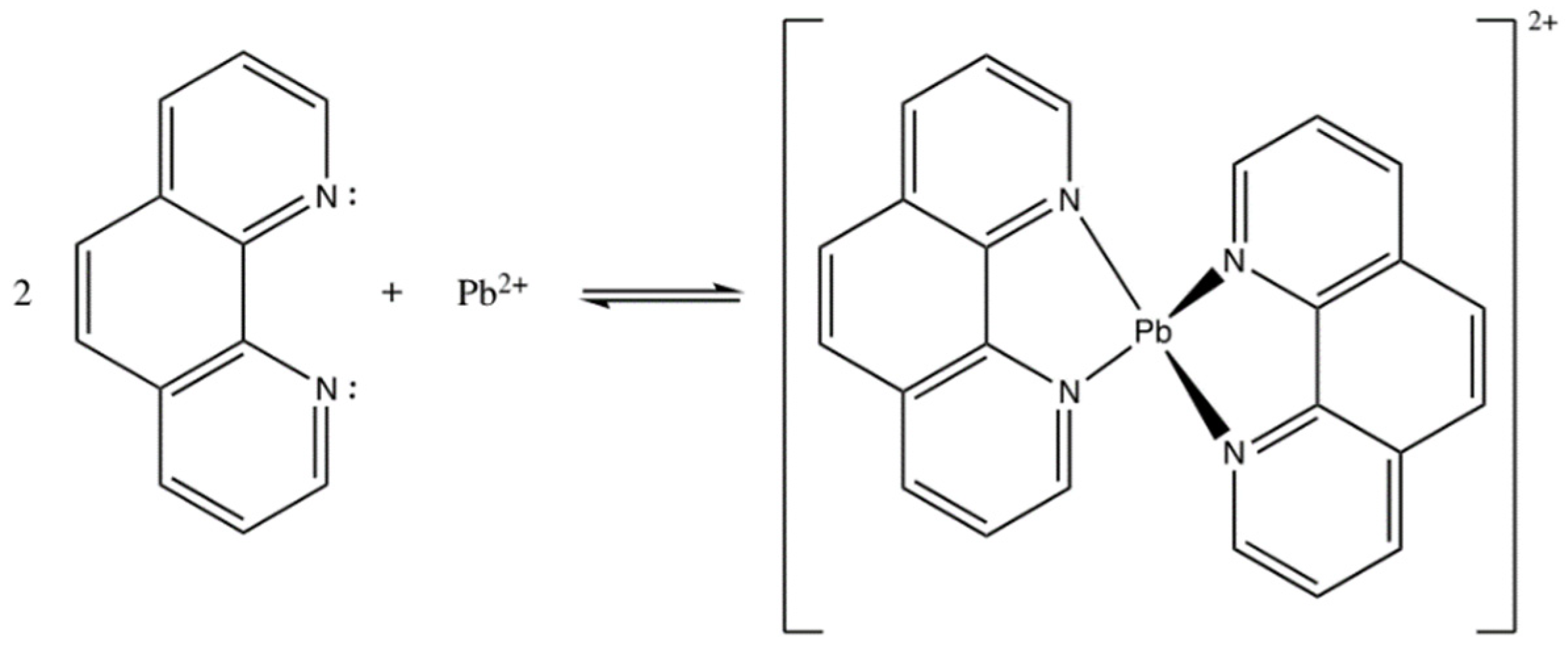
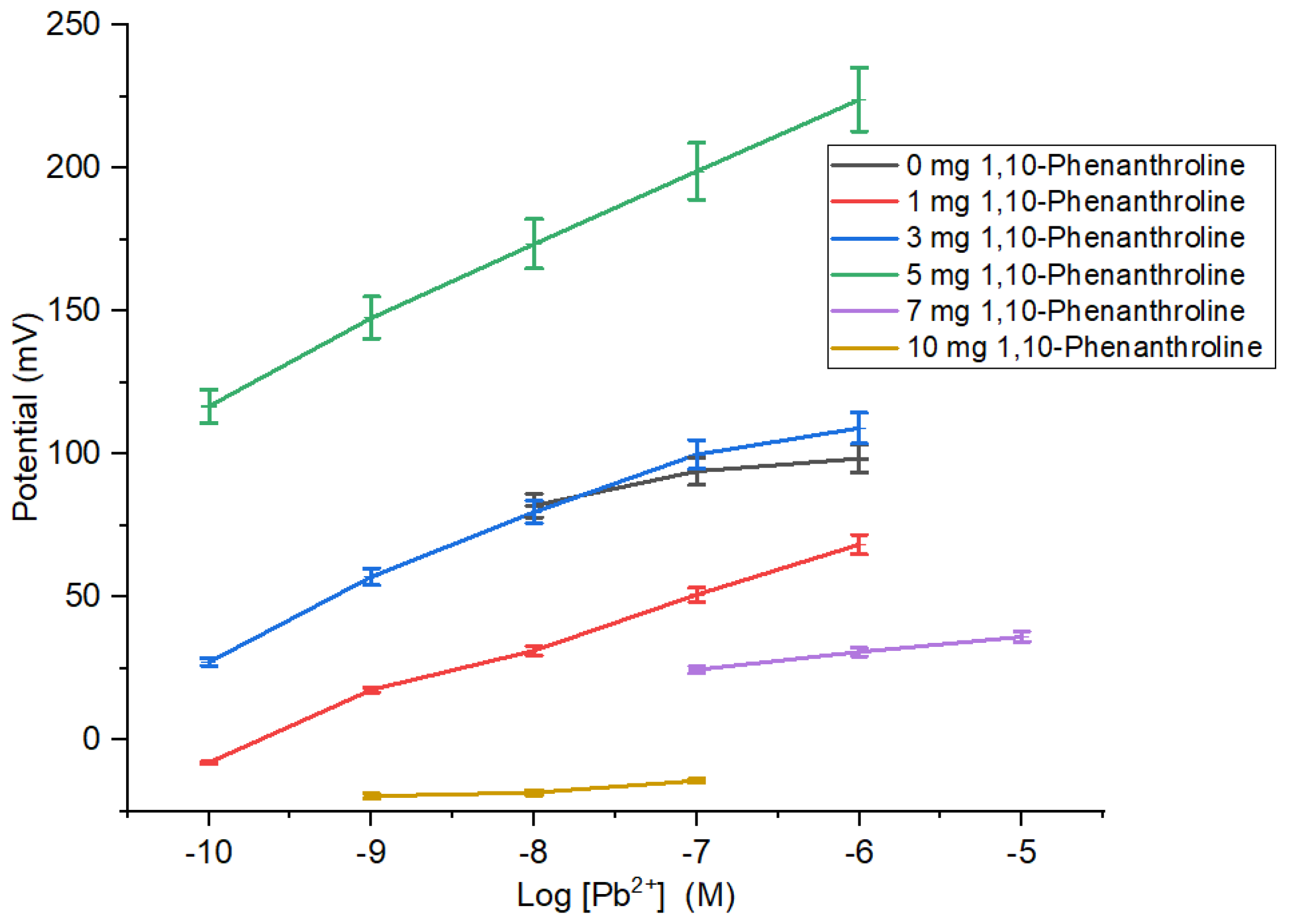
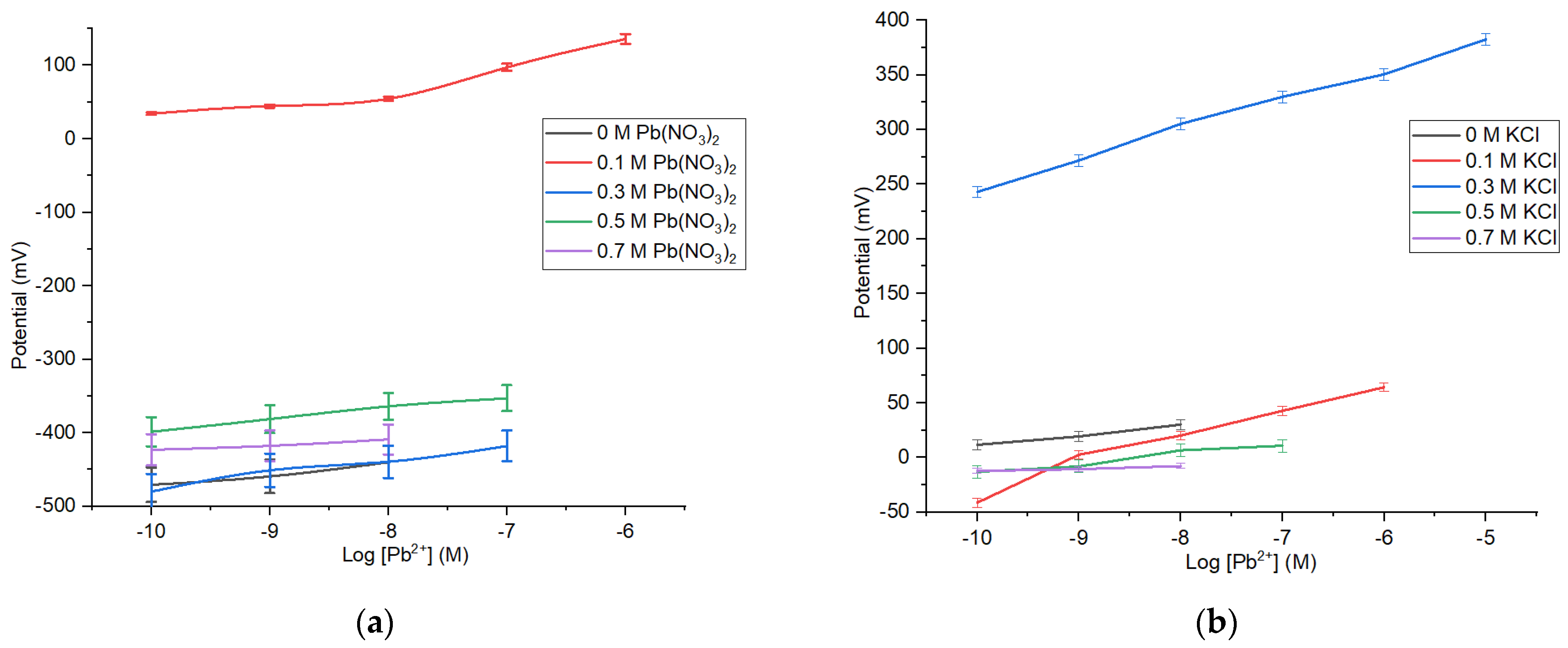
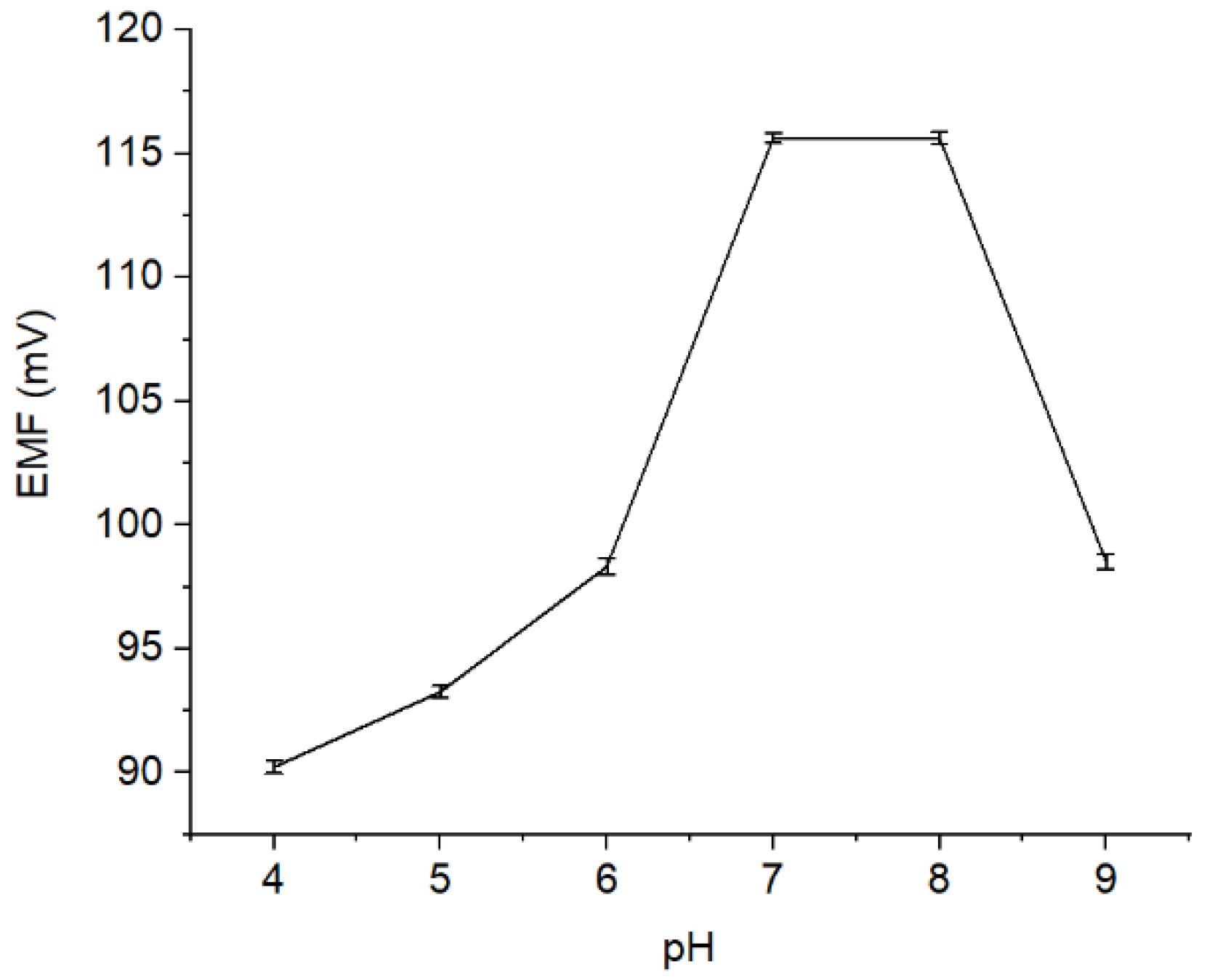
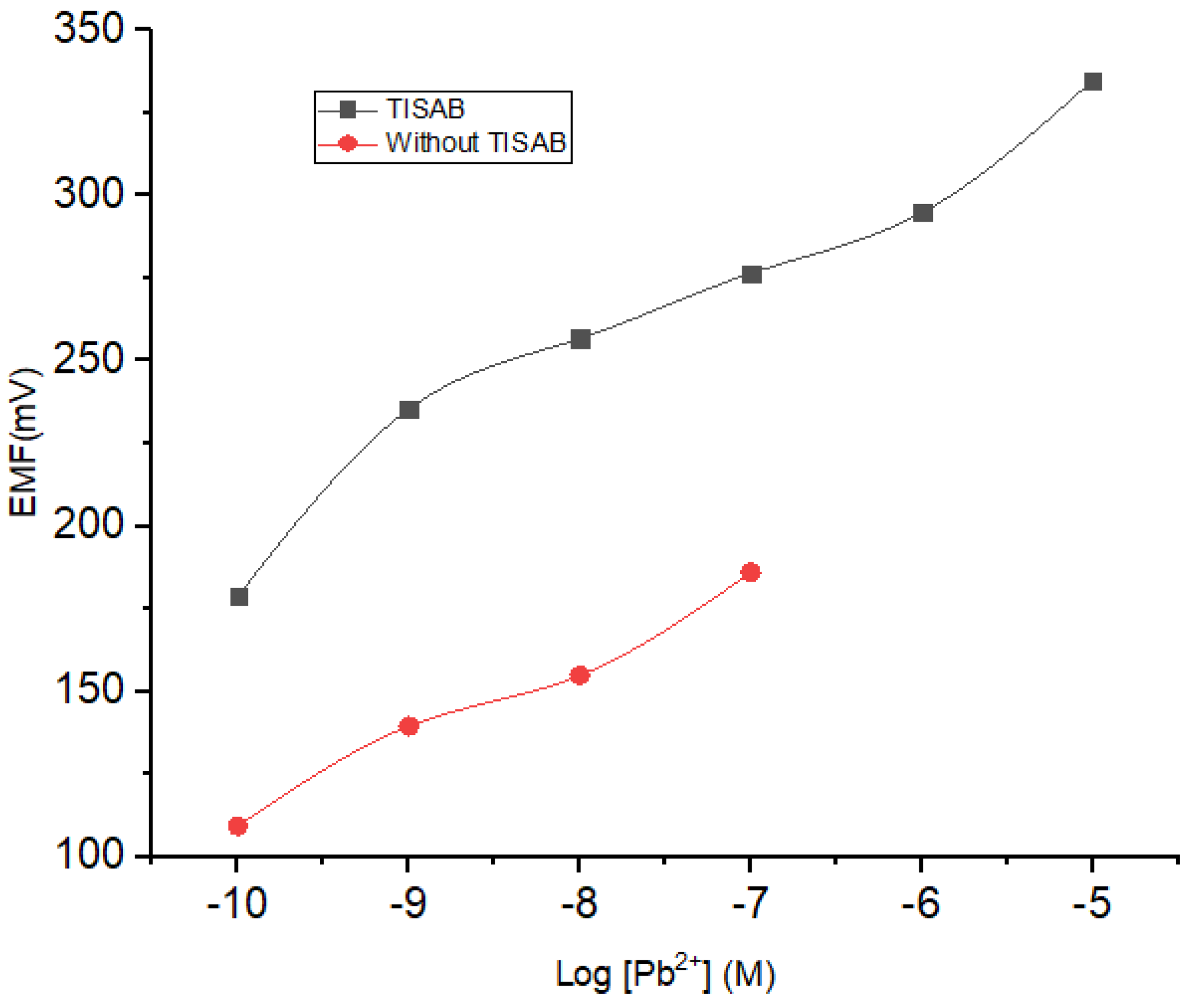
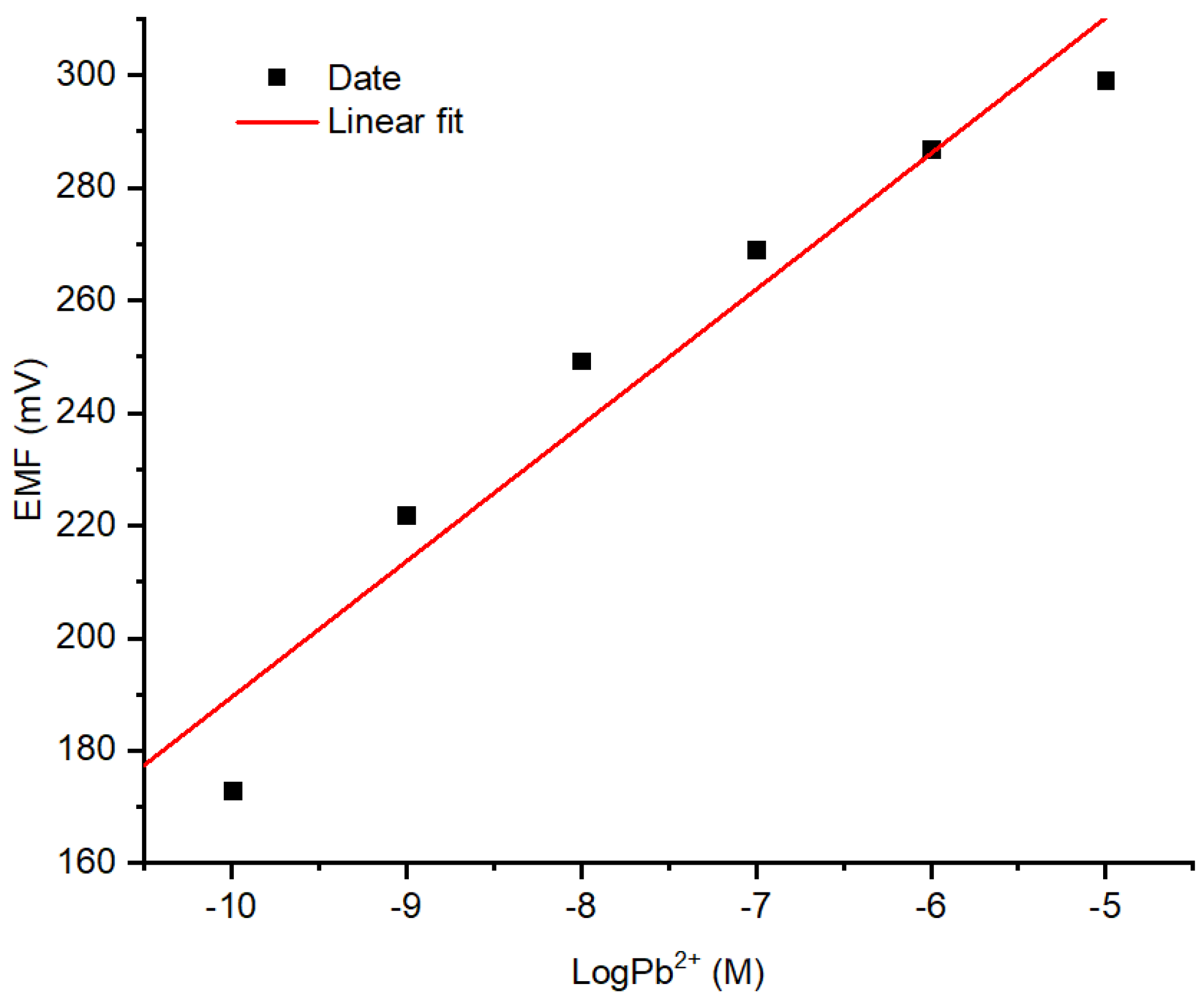
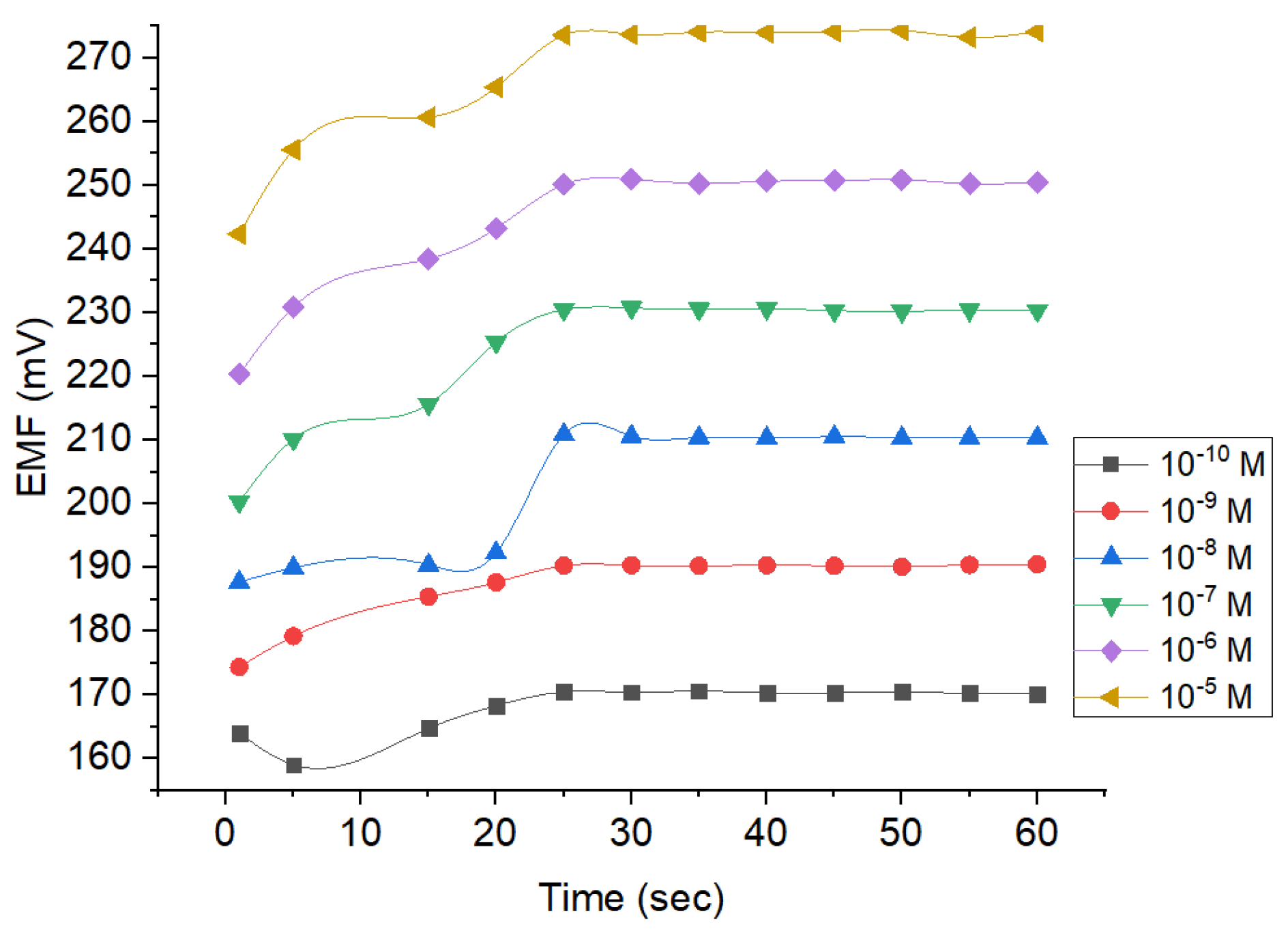
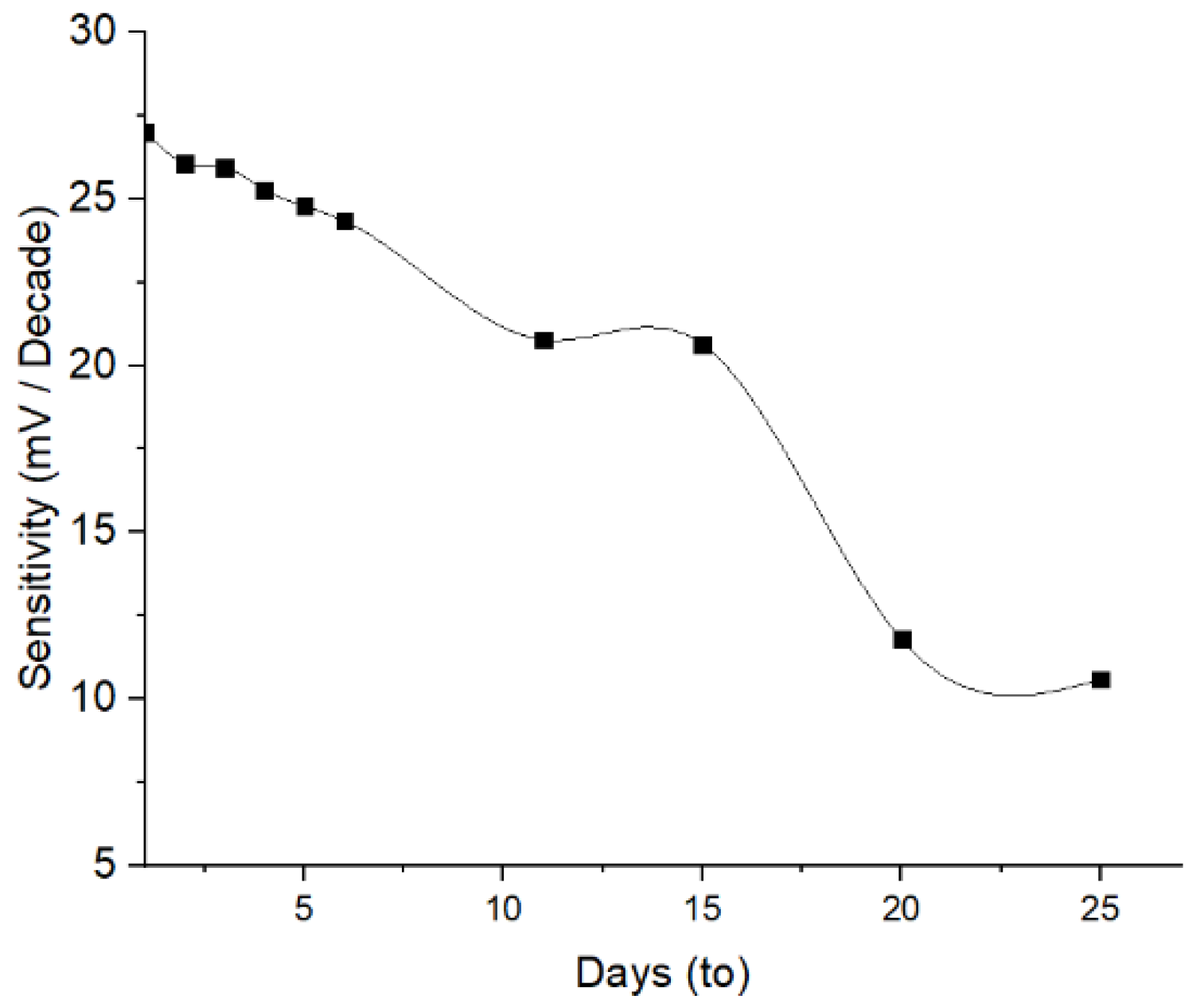
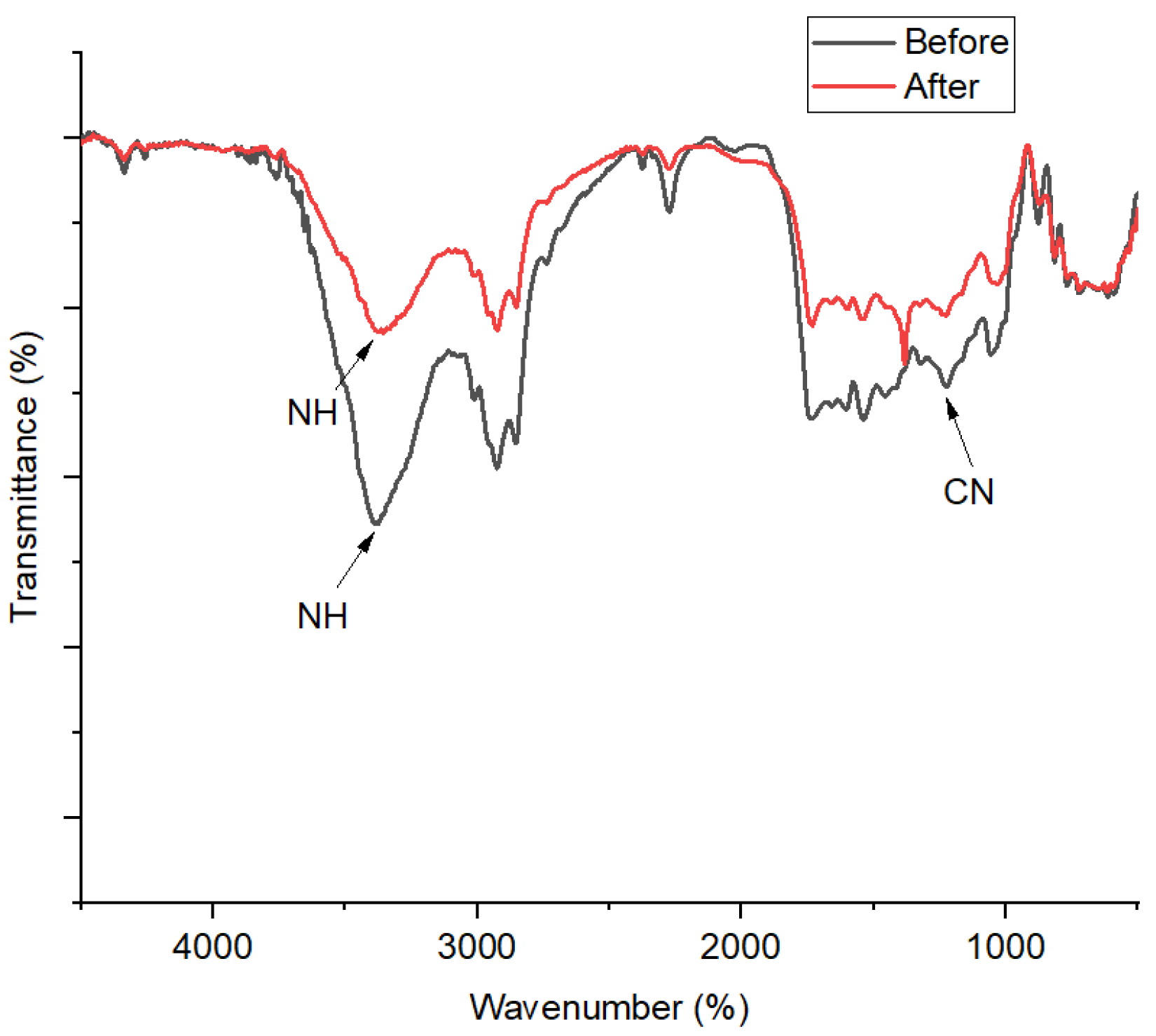
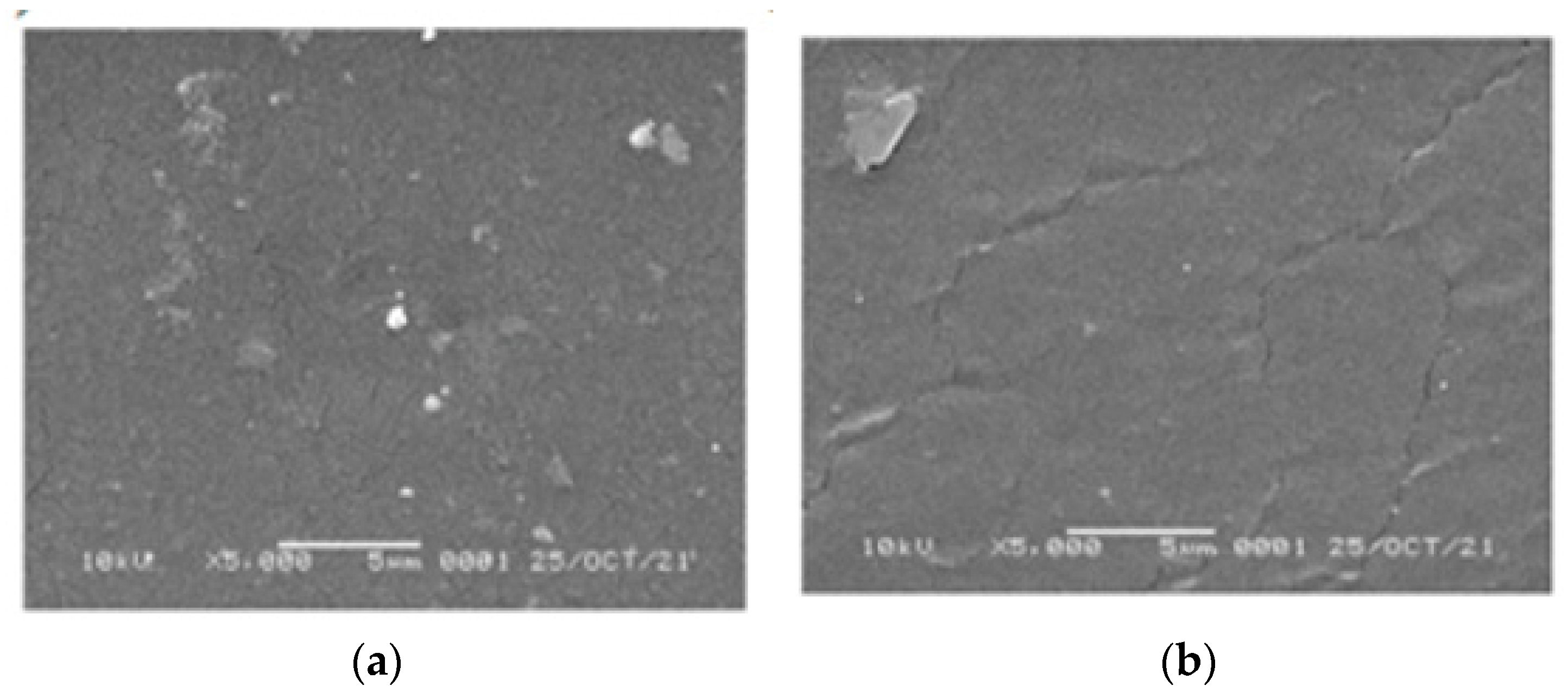

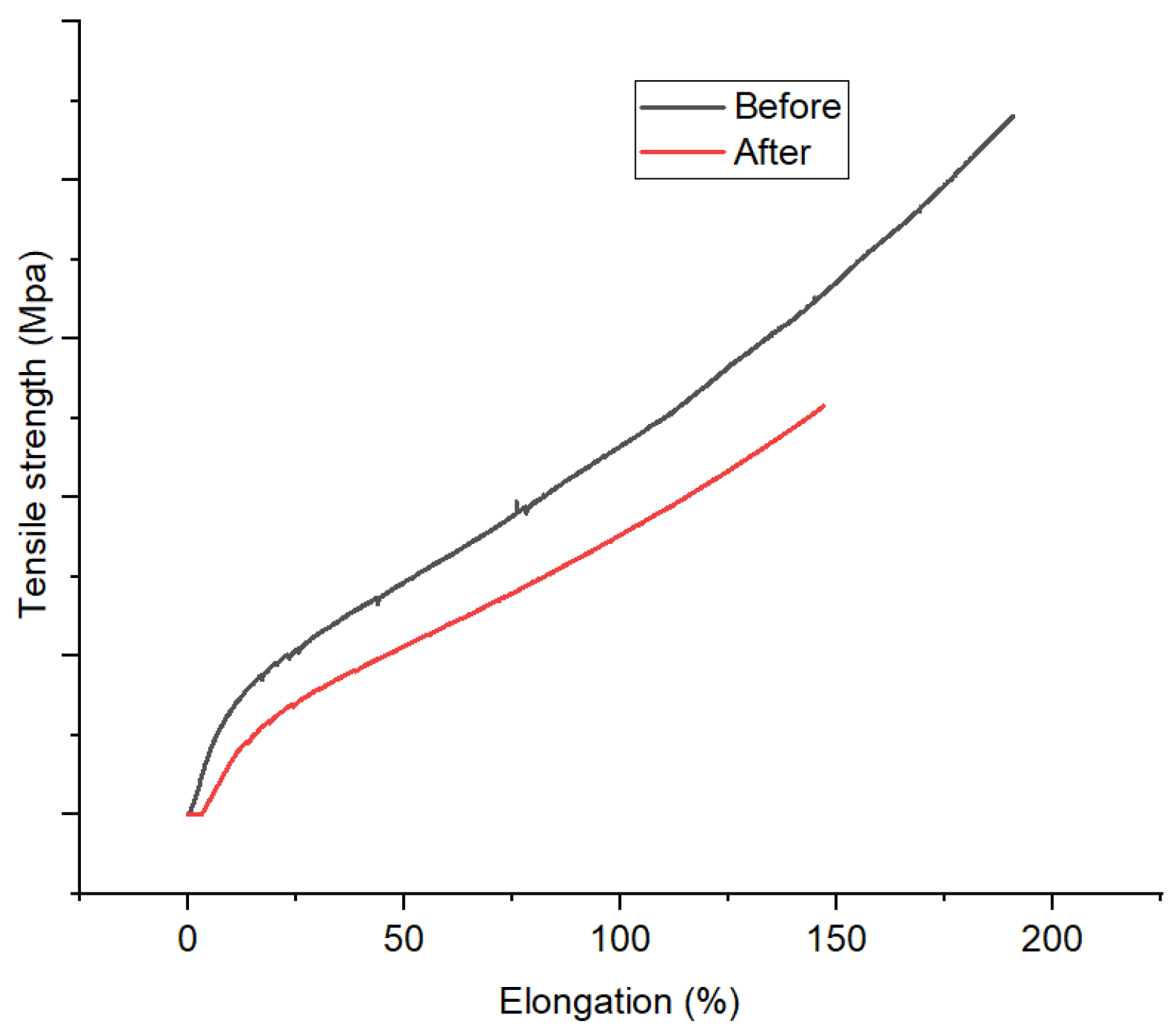
| 1,10-Phenanthroline (mg) | Sensitivity (mV/Decade) | Linear Range (M) | R2 |
|---|---|---|---|
| 0 | 8.19 ± 0.15 | 10−10–10−8 | 0.966 ± 0.03 |
| 1 | 18.45 ± 0.14 | 10−10–10−6 | 0.962 ± 0.05 |
| 3 | 20.58 ± 0.13 | 10−10–10−6 | 0.976 ± 0.02 |
| 5 | 26.46 ± 0.11 | 10−10–10−6 | 0.985 ± 0.01 |
| 7 | 5.71 ± 0.13 | 10−7–10−5 | 0.993 ± 0.01 |
| 10 | 2.68 ± 0.03 | 10−9–10−7 | 0.935 ± 0.04 |
| Standart Solution Compositions | Sensitivitas (mV/ Decade) | Linear Range (M) | R2 | |
|---|---|---|---|---|
| Pb(NO3)2 (M) | KCl (M) | |||
| 0.3 | 0 | 15.24 ± 0.13 | 10−10–10−8 | 0.987 ± 0.01 |
| 0.1 | 25.57 ± 0.002 | 10−10–10−6 | 0.950 ± 0.05 | |
| 0.3 | 19.73 ± 0.16 | 10−10–10−7 | 0.978 ± 0.001 | |
| 0.5 | 15.40 ± 0.05 | 10−10–10−7 | 0.975 ± 0.02 | |
| 0.7 | 7.142 ± 0.01 | 10−10–10−8 | 0.970 ± 0.02 | |
| 0 | 0.1 | 9.20 ± 0.1 | 10−10–10−8 | 0.960 ± 0.02 |
| 0.1 | 25.13 ± 0.03 | 10−10–10−6 | 0.990 ± 0.01 | |
| 0.3 | 27.25 ± 0.14 | 10−10–10−5 | 0.991 ± 0.004 | |
| 0.5 | 8.62 ± 0.06 | 10−10–10−7 | 0.973 ± 0.04 | |
| 0.7 | 2.23 ± 0.10 | 10−10–10−8 | 0.962 ± 0.01 | |
| Parameters | With TISAB | Without TISAB |
|---|---|---|
| Sensitivity (mV/Decade) | 24.04 ± 0.11 | 27.44 ± 0.11 |
| Linearity range (M) | 10−10–10−7 | 10−10–10−5 |
| R2 | 0.950 ± 0.002 | 0.953 ± 0.001 |
| [Pb(NO3)2] | Repeation | ||||
|---|---|---|---|---|---|
| I | II | III | IV | V | |
| Sensitivity (mV/decade) | 26.819 ± 0.001 | 26.28 ± 0.003 | 27.28 ± 0.004 | 26.04 ± 0.01 | 25.38 ± 0.02 |
| R2 | 0.994 ± 5.6 × 10−5 | 0.941 ± 3 × 10−4 | 0.94 ± 5.8 × 10−5 | 0.978 ± 1 × 10−4 | 0.991 ± 5.8 × 10−5 |
| Parameter | Electrode Reproducibility | |||||||||
|---|---|---|---|---|---|---|---|---|---|---|
| I | II | III | IV | V | VI | VII | VIII | IX | X | |
| Sensitivity (mV/Decade) | 25.29 ± 0.01 | 24.95 ± 0.02 | 25.42 ± 0.01 | 24.64 ± 0.03 | 24.65 ± 0.03 | 24.65 ± 0.34 | 25.04 ± 0.02 | 24.58 ± 0.08 | 24.26 ± 0.03 | 24.64 ± 0.07 |
| R2 | 0.987 ± 5.77 × 10−5 | 0.986 ± 5.77 × 10−5 | 0.991 ± 1.5 × 10−4 | 0.992 ± 2.1 × 10−4 | 0.992 ± 5.9 × 10−4 | 0.992 ± 2 × 10−4 | 0.997 ± 5.77 × 10−5 | 0.993 ± 5.1 × 10−4 | 0.996 ± 1.1 × 10−4 | 0.996± 2.1 × 10−4 |
| Foreign Ions | Log Kij |
|---|---|
| Ag2+ | −6.14 ± 0.0002 |
| Ca2+ | −6.68 ± 0.02 |
| K+ | −7.18 ± 0.002 |
| Mg+ | −7.26 ± 0.005 |
| Cu2+ | −7.31 ± 0.005 |
| Fe3+ | −7.92 ± 0.007 |
| Cr3+ | −8.48 ± 0.002 |
| Zn2+ | −8.49 ± 0.02 |
| Cd2+ | −8.73 ± 0.004 |
| Sample Pb(NO3)2 (mg/L) | Pb(NO3)2 (mg/L) | t-Measure | T Table | |
|---|---|---|---|---|
| Pb2+ ISE | AAS | |||
| 6.8 | 6.8 ± 0.04 | 6.6 ± 0.04 | 0.146 | 4.32 |
| 7.6 | 7.6 ± 0.05 | 7.2 ± 0.03 | 0.131 | |
| Real wastewater | 2.4 ± 0.09 | 2 ± 0.062 | 0.133 | |
Publisher’s Note: MDPI stays neutral with regard to jurisdictional claims in published maps and institutional affiliations. |
© 2022 by the authors. Licensee MDPI, Basel, Switzerland. This article is an open access article distributed under the terms and conditions of the Creative Commons Attribution (CC BY) license (https://creativecommons.org/licenses/by/4.0/).
Share and Cite
Nisah, K.; Rahmi, R.; Ramli, M.; Idroes, R.; Alva, S.; Iqhrammullah, M.; Safitri, E. Optimization of Castor Oil-Based Ion Selective Electrode (ISE) with Active Agent 1,10-Phenanthroline for Aqueous Pb2+ Analysis. Membranes 2022, 12, 987. https://doi.org/10.3390/membranes12100987
Nisah K, Rahmi R, Ramli M, Idroes R, Alva S, Iqhrammullah M, Safitri E. Optimization of Castor Oil-Based Ion Selective Electrode (ISE) with Active Agent 1,10-Phenanthroline for Aqueous Pb2+ Analysis. Membranes. 2022; 12(10):987. https://doi.org/10.3390/membranes12100987
Chicago/Turabian StyleNisah, Khairun, Rahmi Rahmi, Muliadi Ramli, Rinaldi Idroes, Sagir Alva, Muhammad Iqhrammullah, and Eka Safitri. 2022. "Optimization of Castor Oil-Based Ion Selective Electrode (ISE) with Active Agent 1,10-Phenanthroline for Aqueous Pb2+ Analysis" Membranes 12, no. 10: 987. https://doi.org/10.3390/membranes12100987







